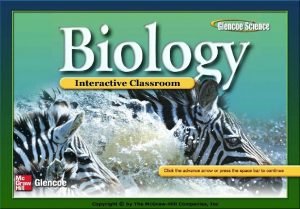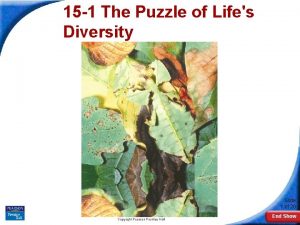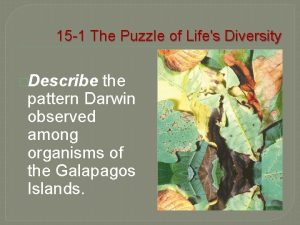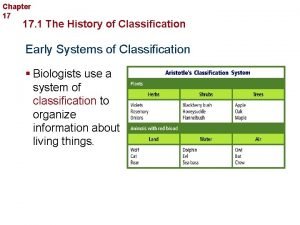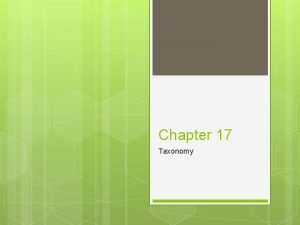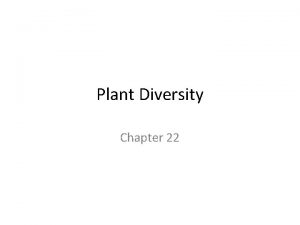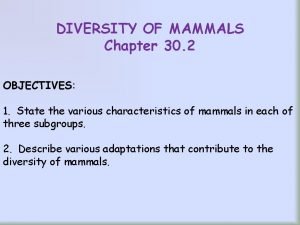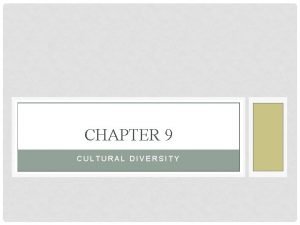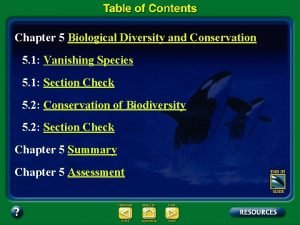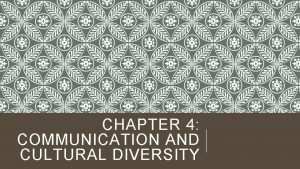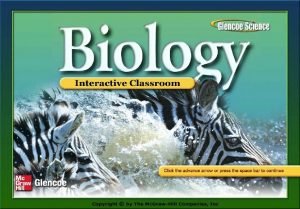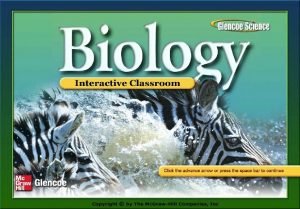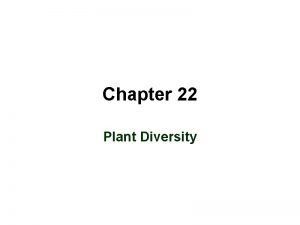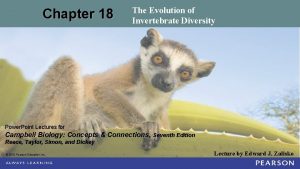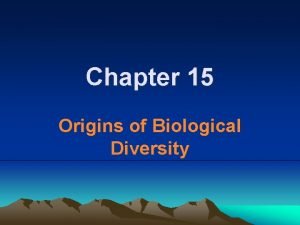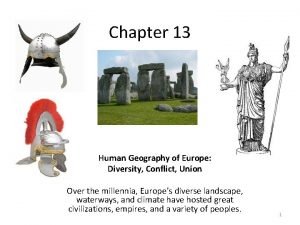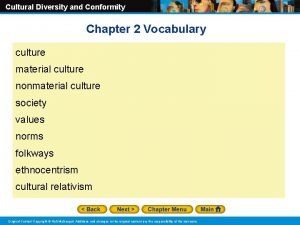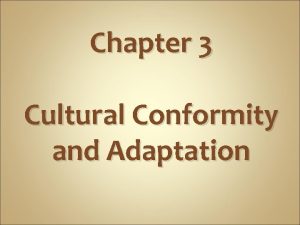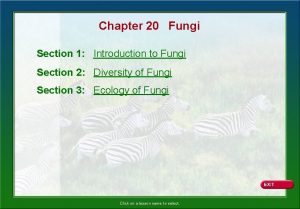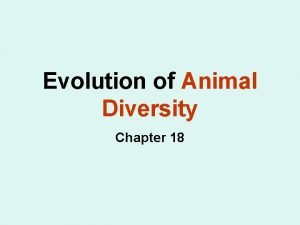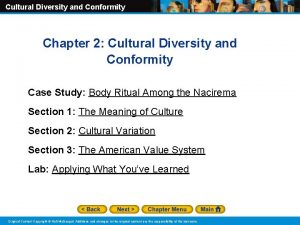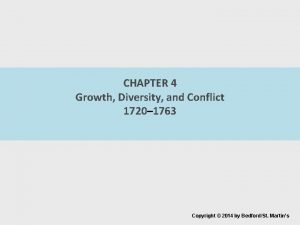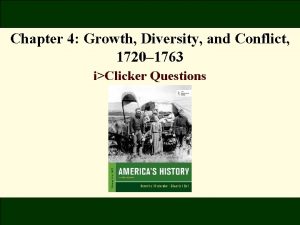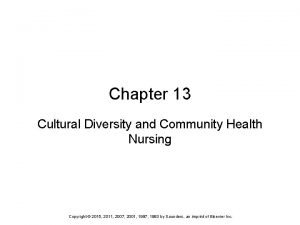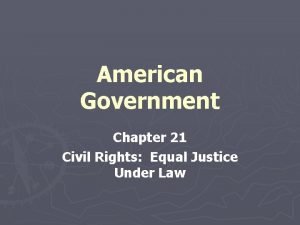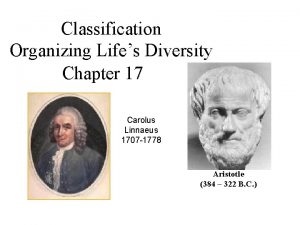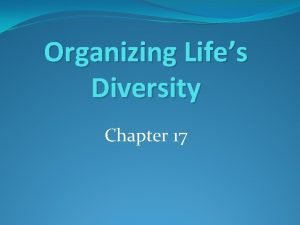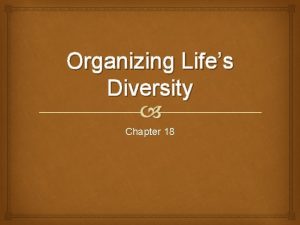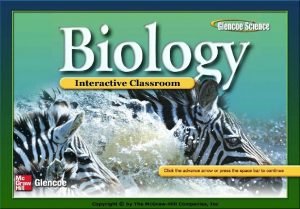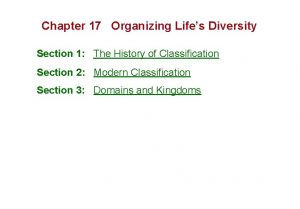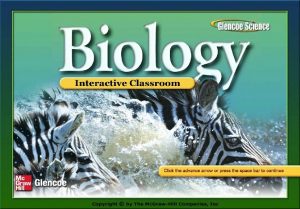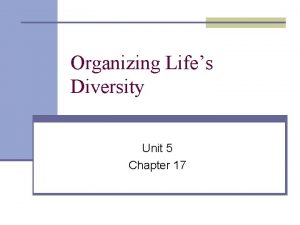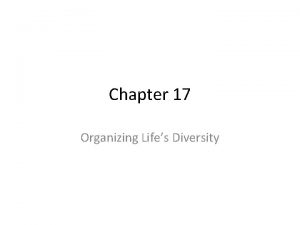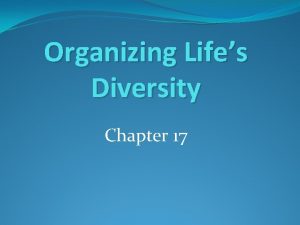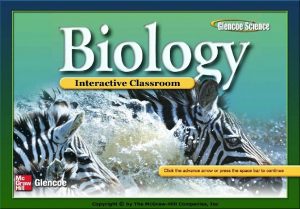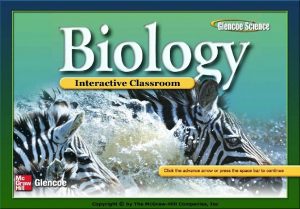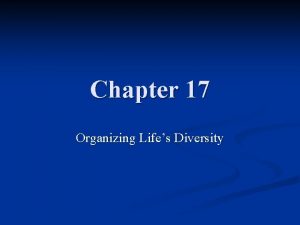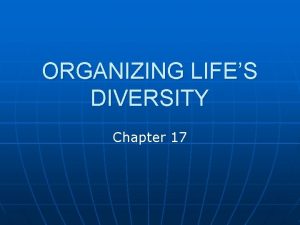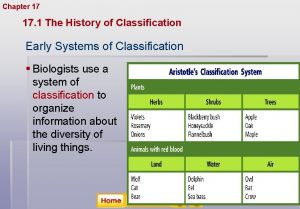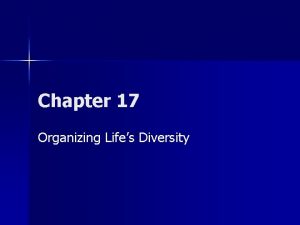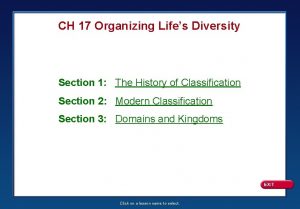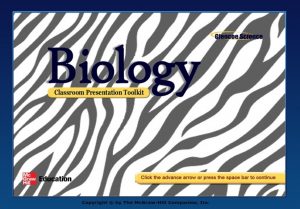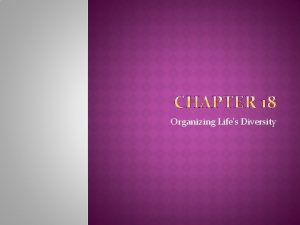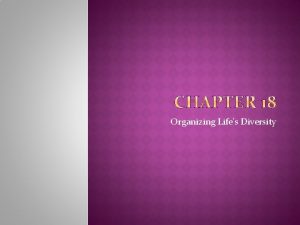CHAPTER 17 Organizing lifes diversity Early Systems of







































- Slides: 39

CHAPTER 17 Organizing life’s diversity

Early Systems of Classification ■ Classification – is the grouping of objects or organisms based on a set of conditions. – A regular system of classification helps scientist organize and communicate information about biology.

Aristotle’s Classification System ■ More than 2, 000 years ago Aristotle ( a Greek philosopher) developed the first commonly accepted system of biological classification. ■ Classified organisms as either animals or plants. – Animals were classified by their habitat, their morphology and the presence of red blood. (“bloodless” or “red blood”) – Plants were classified by average size and structure (as trees, shrubs, or herbs)

What Were the Limitations of Aristotle’s System? 1) This system was based on his understanding that species are distinct, separate , and unchanging. *This did not account for evolutionary change. 2) Many organisms have been discovered that do not fit into this system ( birds that do not fly, frogs that live on land not water) ■ Was eventually replaced by a new system.

Linnaeus Classification System ■ Swedish botanist (lived during the 18 th century) ■ Developed a branch of biology called Taxonomy. – A discipline in biology concerned with identifying, naming, and classifying species based on the morphological and behavioral similarities and differences or organisms. – Part of the larger branch of biology called Systematics. (the Study of biological diversity) ■ This system is built on the foundation of Aristotle’s system of classification.

Binomial Nomenclature ■ Linnaeus named organisms using Binomial Nomenclature. ■ Gives each species a scientific name that has two parts. 1. The Genus Name 2. The Species Name (Scientific name that identifies that species) ■ Latin is used for binomial nomenclature because Latin is a language that is unchanging.

Why do Scientist use Scientific Names? ■Common names vary in their use and can be misleading (starfish).

When writing Scientific names, scientist follow certain rules: 1) The first letter of the genus name is always capitalized, but the rest and the scientific epithets are lowercase. 2) If a scientific name is printed in a book or magazine it is italicized. 3) If a scientific name is written by hand, it is underlined. 4) After the complete scientific name has been written once, the genus will often be abbreviated to the first letter when used again. ( Cardinalis cardinalis will be written as C. cardinalis )

Taxonomic Categories ■ Taxonomist classify organisms by dividing them into smaller groups based on more specific criteria. ■ Categories are arranged from broadest to most specific. ■ A named group of orgamisms us called a Taxon. (plural, Taxa)

Species and Genus ■ A Genus is defined as a group of species that are closely related and share a common ancestor. ■ A Species is a group of organisms that have similar characteristics such as a skull shape and size. The Species American black bear (Ursus americanus) and Asiatic black bear (Ursus thibetanus) belong to the genus Ursus. American black bear (Ursus All species in this genus have massive skulls and similar tooth structures. Asiatic black bear (Ursus thibetanus

Family ■ A Family is a group of genera that have similar characteristics. – All Bears living and extinct belong to the family Ursidae. – All member of this family have similar characteristics. ( walk flat-footed and have forearms that can rotate and grasp prey closely)

Higher Taxa ■ An Order is a group of families that have similar characteristics. ■ A Class is a group of one or more related orders. ■ A Phylum (or division) is a group of related classes. – Division is used for bacteria and plants ■ A Kingdom is a group of relates phyla (or divisions) ■ A Domain Is a group of one or more kingdoms.

Mnemonic Devices King Phillip Came Over For Green Soup Kingdom Phylum Class Order Family Genus Species



Modern Classification: Typological Species Concept. ■ Aristotle and Linnaeus ■ The Typological Species Concept is based on the idea that species are unchanged, distinct, natural “types”. ■ Because Evolution causes species to change ( makes variations) this concept was changed.

Biological Species Concept ■ 1930’s to 1940’s the term Species was redefined as a group of organisms that are able to interbreed and produce fertile offspring in a natural setting. – This definition is known as the Biological species concept. ■ However there are limitations to the concept. – Wolves and dogs are classified as two diff. species ( But they are known to interbreed and produce fertile offspring) – Does not consider extinct species or species that interbreed asexually.

Phylogenetic Species Concept ■ Defines diff. species as a group of organisms that is diff. from other groups of organisms and that has, within the group, a pattern of ancestry and decent. ■ Phylogeny is the evolutionary history of a species. ■ When a phylogenic species branches, it becomes two different phylogenic species. (isolation)

Characters ■ To determine the species of an organism, scientist have put together pieces of evolutionary history, also called phylogenies, using characters. ■ Characters are inherited features that vary among species. – Can be morphological or biochemical.

How are Morphological Characters ■ Morphological characters suggest that a species might be Used? closely related and that they evolved from a recent common ancestor. ■ Analogous characters do not. (analogous- same f(x) but different structure) Oviraptor Dinosaur fossils showed that they had feathers and large hollow spaces in their bones. With hips, leg, wrist, and shoulder structures similar to birds. Sparrow

How are Biochemical Characters used? ■ The number and structure of chromosomes provide info. About evolutionary relationships among species. These similarities suggest a common evolutionary history. * Chromosomes are strands of DNA (genetic material) that become visible during mitosis and meiosis. ■ Scientist study and understand evolutionary relationships by sequencing DNA of diff. organisms. – They compare the sequenced DNA or organisms to each other. – Organisms that are closely related have

Broccoli Cauliflower Cabbage Kale All of these vegetables look different, but they have almost the same chromosome structures, which suggest that they have a close evolutionary relationship.

Molecular Clocks ■ Because mutations occur randomly in DNA as time goes on mutations tend to build up in the chromosomes. The rate at which these mutations build up can be viewed as a molecular clock. ■ A Molecular Clock is a model that uses comparisons if DNA sequences to estimate how long a species has been evolving. ■ The molecular clock is used along with fossil records to identify the time of divergence of a species.

Phylogenetic Reconstruction ■ Cladistics is a way to study evolutionary relationships that rebuilds phylogenies and hypothesizes evolutionary relationships based on shared structures. ■ These hypothesized relationships suggest how diff. groups of organisms might have evolved.

Main Character Types. ■ There are two main character types that need to be considered when using cladistics : 1. Ancestral characters – found in a variety of groups within the line of descent. 2. Derived characters – present in one group within the line of descent, but it is nor found in the common ancestor. § When comparing two groups: 1. Ancestral characters evolved in a common ancestor of both groups. 2. Derived character evolved in an ancestor of one group.

For example: ■ When comparing birds and mammals, a backbone is an ancestral character because both birds and mammals have backbones and both have ancestral with backbones. ■ Feathers are derived characters because only birds have an ancestor with feathers. ■ Hair is also a derived character because only mammals have an ancestor with hair.

Cladogram ■ A branching diagram that shows the proposed phylogeny of a species. – Put together by scientist by using ancestral characters and derived characters. – Similar to a pedigree § The groups in a cladogram (Clades) have one or more related species. § The branches of a cladogram show hypothesized phylogeny. § Depends on info from DNA and RNA. § Scientist hypothesize the ancestor's character types based on the traits of its descendant

How is a cladogram made? Ferns Mosses Nodes Conifers Lilies Clade Flowers (derived character) Seeds (derived character) Vascular tissue (derived character) Anchors or roots (ancestral character) Ancestor with chloroplasts (ancestral character) • First the derived character – vascular tissue, seeds, and flowers were identified. • Then the ancestry of a variety of species was identified based on whether the species had some or all of the derived characters.

What is a phylogenetic tree? ■ Used to show the relationship among species and groups of organisms. ■ Is a form of a cladogram in which each node with descendants represents a common ancestor. The tree branches show species and the nearby branches represent similar species.

Grouping Species ■ There are three domains and six kingdoms within those domains. ■ Organisms are classified into domains based on cell types and structure. ■ Organisms are classified into kingdoms based on cell type, structure, and nutrition.

Prokaryotes Bacteria - Unicellular organisms that do not have membranebound organelles. Classified into two domains Archaea

Domain Bacteria ■ Prokaryotes whose cell walls contain peptidoglycan ( a polymer that contains two kinds of sugars) ■ Contains kingdom Bacteria ■ Characteristics: – Unicellular organism with no nucleus or other membrane bound organelles. – Can survive many environments – Some aerobic ( need oxygen to live) – Others anaerobic ( can’t live without oxygen) – Some autotropic ( make their own food ) – Most heterotrophic ( get nutrients from other organisms) Bacteria come in many size and shapes and are more abundant than any other organisms.

Domain Archaea Characteristics: ■ Are prokaryotes ■ Contains kingdom Archaea ■ Unicellular organisms that so not have a nucleus or any other membrane bound organelles. ■ Cell walls do not contain peptidoglycan and have some similarities to eukaryotes. ■ Found in many shapes ■ Obtain nutrients in many ways ■ Some autotrophic but most heterotrophic ■ Live in extreme environments (hot springs, salty lakes, thermal vents, little to no oxygen)

Domain Eukarya ■Organisms with membranebound ■Contains kingdom Protista, kingdom Fungi, kingdom Plantae, and kingdom Animalia.

Kingdom Protista ■ Members of this kingdom are called protist. ■ Protist are eukaryotes and have membrane bound organelles. ■ Can be unicellular, a colony of cells, or multicellular. ■ Classified into three groups: 1. Plantlike protists■ ■ ■ Called Algae Autotropic Preform photosynthesis 2. Animal-like protists § § Called protozoans Amoebas 3. Funguslike protists § § § Slime molds and mildews Have both plant like and animal like characteristics Preform photosynthesis

Kingdom Fungi ■ Members of this kingdom are called fungus Characteristics: ■ Fungus are eukaryotes that absorb nutrients from organic materials in its environment. ■ Cannot move ■ Unicellular and multicellular with cell walls made of chitin ■ Heterotrophic ■ Live in a many environments

Kingdom Plantae ■ Members of this kingdom are called plants ■ Made up of more then 250, 000 species of plants Characteristics: • Multicellular - cell walls contain cellulose • Autotrophs • Carry out photosynthesis • Few from other organisms • Live in water and on land

Kingdom Animalia ■ Members called animals Characteristics: § Heterotrophs § Multicellular § Eukaryotic with membranebound organelles § Do not have cell walls ( walls organized into tissues) § Live in water , on land, and

Kingdom Cell type and Structure Nutrition Habitat Mobility Bacteria Prokaryotes with cell walls made of peptidoglycan Most heterotrophic; some autotrophic Live in many environments Can move Archaea Prokaryotes with cell walls that are not made of peptidoglycan Most are heterotrophic; some autotrophic Live in extreme environments Can move Protista Unicellular and multicellular eukaryotes Heterotrophic and Autotrophic Live in moist environments Can move Fungi Unicellular and multicellular eukaryotes with cell walls made of chitin Heterotrophic Live in most environments Cannot move Plantae Multicellular eukaryotes with cell walls make of cellulose Most are autotrophic Live in water and on and preform land photosynthesis; some Heterotrophic Multicellular Heterotrophic Cannot move Live in water, on land, Most can move; some
 Organizing lifes diversity
Organizing lifes diversity The puzzle of life's diversity
The puzzle of life's diversity Section 15-1 the puzzle of lifes diversity
Section 15-1 the puzzle of lifes diversity Chapter 17 organizing life's diversity
Chapter 17 organizing life's diversity Circle lifes
Circle lifes 4 lifes
4 lifes When upon
When upon Organizing life's diversity
Organizing life's diversity Genetic diversity vs species diversity
Genetic diversity vs species diversity Genetic diversity vs species diversity
Genetic diversity vs species diversity Early cpr and early defibrillation can: *
Early cpr and early defibrillation can: * Chapter 2 worksheet organizing and administering
Chapter 2 worksheet organizing and administering Operating system and example
Operating system and example Early operating systems
Early operating systems Earthquake early warning systems
Earthquake early warning systems Earthquake early warning systems
Earthquake early warning systems Chapter 22 plant diversity answer key
Chapter 22 plant diversity answer key Chapter 30 section 2 diversity of mammals
Chapter 30 section 2 diversity of mammals Chapter 9 cultural competence
Chapter 9 cultural competence Chapter 8 human resources culture and diversity
Chapter 8 human resources culture and diversity Chapter 8 study guide human resources culture and diversity
Chapter 8 study guide human resources culture and diversity Diversity and human needs and development
Diversity and human needs and development Biological diversity and conservation chapter 5 answers
Biological diversity and conservation chapter 5 answers Chapter 4 communication and cultural diversity
Chapter 4 communication and cultural diversity Class mammalia characteristics
Class mammalia characteristics Chapter 26 section 3 insects and their relatives
Chapter 26 section 3 insects and their relatives Biology chapter 22 plant diversity answer key
Biology chapter 22 plant diversity answer key Chapter 18 the evolution of invertebrate diversity
Chapter 18 the evolution of invertebrate diversity Chapter 15 origins of biological diversity answers
Chapter 15 origins of biological diversity answers Chapter 13 diversity conflict union
Chapter 13 diversity conflict union Chapter 10 cultural diversity
Chapter 10 cultural diversity Cultural diversity and conformity section 1
Cultural diversity and conformity section 1 Cultural diversity and conformity chapter test form a
Cultural diversity and conformity chapter test form a Life cycle of zygomycete
Life cycle of zygomycete Animal diversity chapter
Animal diversity chapter Cultural diversity and conformity section 2
Cultural diversity and conformity section 2 Growth diversity and conflict chapter 4
Growth diversity and conflict chapter 4 Chapter 4 growth diversity and conflict
Chapter 4 growth diversity and conflict Culturological assessment
Culturological assessment Government chapter 21 diversity and discrimination
Government chapter 21 diversity and discrimination
